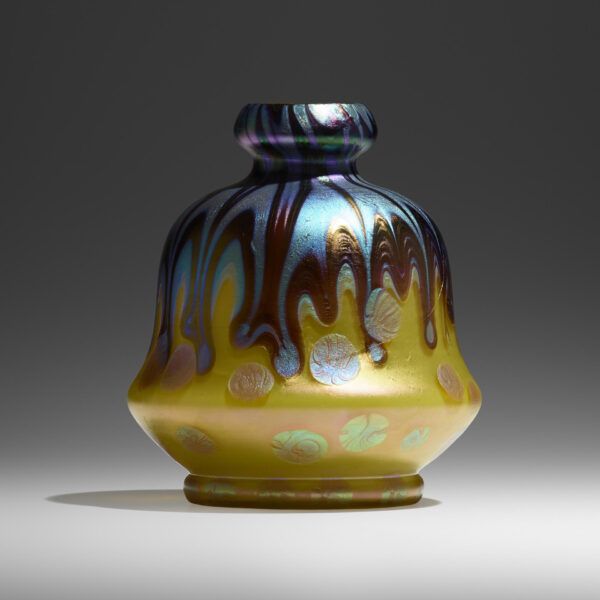
.
.
.
#LoetzGlass #ArtNouveau #VintageGlassware #CollectibleArtGlass #IridescentGlass #BohemianGlass #LoetzWitwe #PhänomenSeries #CytisusCollection #TitaniaDesigns #RareGlassware #GlassArtCollector #HistoricGlass #LoetzMasterpieces #DecorativeGlassArt
Loetz glassware, renowned for its innovative designs and iridescent beauty, stands as a pinnacle of Art Nouveau craftsmanship. While the Bohemian glassworks, established in 1836 by Johann Eisner, produced high-quality art glass for decades, its most celebrated creations emerged during the Art Nouveau period (circa 1890–1910). These pieces, characterized by their organic forms, intricate patterns, and shimmering finishes, are highly sought after by collectors today. Some command prices in the tens of thousands of dollars, particularly those with unique decorative techniques like the “oil spot” pattern, which features small iridescent spots that create a mesmerizing, multicolored effect.
The company’s success can be attributed to Maximilian von Spaun, who took over in 1879 and encouraged experimentation. Under his leadership, Loetz artists developed groundbreaking techniques and innovative glass types, such as the marbled Marmoriertes effect and the Octopus pattern with its tentacle-like swirls. However, Loetz’s most significant contributions came during the Art Nouveau era, when its artists, inspired by the work of Tiffany Studios and René Lalique, introduced the celebrated Phänomen series. This line, characterized by flowing, water-like patterns and metallic iridescence, earned Loetz international acclaim, including a Grand Prix at the 1900 Paris World Exhibition.
Loetz glass is prized for its technical mastery, artistic innovation, and vibrant colors. While green glass was more common, the company’s artists achieved exotic hues like cobalt blue, ruby, and uranium by meticulously manipulating impurities and heat. Pieces with gold metallic luster or rare colors are particularly valuable. Additionally, many Loetz creations feature attractive metal frames that enhance their design.
Collectors should pay attention to craftsmanship, decoration, form, condition, and attributions to specific artists, such as Franz Hofstötter, Marie Kirschner, Koloman Moser, or Michael Powolny. Authenticity can often be verified by identifying marks, such as the von Spaun family coat of arms, which was first used in 1898. The highest recorded price in WorthPoint’s database is $62,500 for an iridescent vase by Hofstötter, underscoring the enduring appeal of Loetz glass.
Highlights of Loetz’s Art Nouveau Lines
Phänomen Line
Introduced in 1898, the Phänomen line exemplifies Loetz’s technical and artistic innovation. Its metallic iridescence and combed, trailing threads create dynamic, feather-like patterns. Pieces like Phänomen 2/284 (Medici) and Phänomen 6893 are especially sought after. A rare vase by Hofstötter from this line sold for $60,000 in 2022, while most pieces fetch between $1,000 and $4,200.
Cytisus Line
Debuting in 1902, the Cytisus line features vibrant colors like lemon-yellow and metallic-yellow, accented by wavy blue, green, or red threads and mother-of-pearl spots. These pieces, known for their eye-catching appeal, typically sell for $1,000 to $6,500.
Titania Line
Launched in 1905, the Titania series showcases Loetz’s mastery of complex techniques. Its designs, drawn over a colored ground with gray glass threads, are encased in colorless glass for added contrast and depth. Prices for Titania pieces generally range from $1,000 to $5,000.
Later Innovations: The Tango Series
After the Art Nouveau era, Loetz embraced the Art Deco movement with its Tango series. Designed by Michael Powolny, these pieces feature bold colors and contrasting elements, such as handles or lip wraps, on mostly unadorned surfaces.
Collecting Loetz Glass
Collectors prize Loetz glass for its artistic and historical significance. Key factors influencing value include rarity, craftsmanship, and attributions to specific designers. The most valuable pieces are those from the Art Nouveau period, particularly the Phänomen, Cytisus, and Titania lines, which showcase Loetz’s technical brilliance and artistic vision.
With its distinctive styles and exceptional craftsmanship, Loetz glass remains a benchmark in the decorative arts. Its ability to blend tradition with innovation continues to captivate collectors and enthusiasts worldwide.
Adina K. Francis is a writer and editor with over two decades of experience in the antiques and collectibles field. She has a passion for Victorian history and a deep appreciation for dogs.
WorthPoint—Discover. Value. Preserve.


